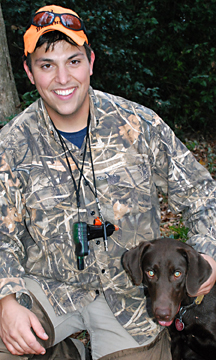Backyard Birddog Training ( Part #2)
Posted on August 31, 2011 by bob in OffTheBeatenPath
Two things training books and trainers harp on in training any dog, hunting or not, are repetition and consistency.
Whatever the required task, be it sitting on a whistle blast or taking casts at a distance, practice makes perfect. Also, be consistent: the dog must understand there is only one correct response to a command. If other people don’t require the same thing of your dog as you (like allowing the dog to jump up on them), it creates confusion for the dog because sometimes the dog is rewarded and at other times scolded.
 It’s more cruel to confuse the dog with inconsistencies than it is to ask others to require the same things of your dog that you do. If not, training will be exponentially more difficult because the dog will be unsure what is required of it. Consistency is not a one-time occurrence – it takes repetition to achieve the goals you’ve set for the dog and yourself.
It’s more cruel to confuse the dog with inconsistencies than it is to ask others to require the same things of your dog that you do. If not, training will be exponentially more difficult because the dog will be unsure what is required of it. Consistency is not a one-time occurrence – it takes repetition to achieve the goals you’ve set for the dog and yourself.
It’s a Journey, Not a Trip
You never hear someone say they’re taking a “journey” to the grocery store. “Trip” denotes something of short duration; a journey takes much longer. Dog training is a journey taking many years, but also one that never really ends. Like professional athletes conditioning their bodies for competition who never reach a certain level and cease training, the same goes for dog training. You’ll never reach a point where the dog is “trained” and you just stop training altogether.
Committing to spend the time necessary to train a dog is the hardest part. If you’re not willing to do that then pick another hobby. Like a fine wine, a good hunting dog takes time, and a 100-yard blind retrieve is a masterpiece in motion. As part of the journey be sure to set short term, realistic goals and train accordingly – repetitively and consistently – toward that goal, keeping in mind that the duration of time spent on different phases of training varies between dogs.
Confidence Through Challenge
A reliable retriever must be confident, in him/herself in understanding the command given, and confident in the trainer who issues the command. A right cast to a trained retriever means not only a command to move in one particular direction but also that there should be a bird or training bumper in that direction. The dog learns to trust the trainer through rewards or corrections and in doing so builds its own confidence that it can succeed by following the trainer’s commands.
It is important to continually challenge dogs in training; it’s how you judge progress. When I feel a dog is “getting” a particular command I usually challenge the dog by introducing a new variable. If the dog meets the challenge I know the dog is progressing. If not, I will step back and work on the basics of the previous command to ensure the dog understands it before challenging again. Progress occurs in small steps, not large leaps. In introducing a new variable, it is important to set the dog up for success so that even if the dog does not overcome the new challenge it still succeeds because it followed the underlying command. This builds confidence and eventually, the dog will rise to meet the challenge.
Part 3 in October addresses obedience, innovation, and making training fun.
Niko Corley spends his free time hunting, fishing and enjoying other outdoor activities. He can be contacted at cootfootoutfitters@gmail.com or follow him on Twitter @cootfootoutfitters.











